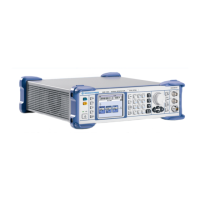R&S SMB Troubleshooting
1407.0806.82 3.17 E-6
Fault Test Action if test fails
Poor Harmonic
Distortion
R&S SMB settings:
• Instrument Preset
• Reference internal
• RF on
• ATT-Mode Auto
• Level = Maximum guaranteed level for
harmonic distortion (see datasheet)
Measure the level of the fundamental
frequency with a spectrum analyzer. The level
of every harmonic has to be at least 30 dB
lower than the level at the fundamental
frequency. Repeat this test over the frequency
range of the instrument.
Comment: In ATT-Mode fixed harmonic
distortion is not guaranteed above Levels
displayed under ‘Level’ menu ‘Attenuator
Settings’ ‘Fixed Range in’.
Most probably the RF Board is
defective. Check the RF Board
being supplied correct (see
page 3.24).
Overvoltage
protection does
not trigger
Switch on RF -> apply a RF power of >2 W to
RF N connector -> The overvoltage protection
must trigger.
If RF output is not switched off and
an error message appears the RF
Board is defective.
Slow Settling
times
Settling times are defined for GPIB remote
control only. The settling time is the time-delay
after asserting EOI until level and frequency
are within the given tolerance from their final
values.
Be careful not to measure with an instrument
drifting on its own due to applying the RF from
the R&S SMB.
Most probably the RF Board is
defective. Check the RF Board
being supplied correct (see
page 3.24).
10 MHz
Reference Input
faulty
Check the 10 MHz reference signal fed into
the R&S SMB with a spectrum analyzer or
frequency counter and power meter. If level
and frequency of this signal is matching the
specification in the datasheet set the
R&S SMB to:
• Instrument Preset
• Reference external
• RF on
• Frequency = 1 GHz
• Level = 0 dBm
Check for error Messages. No “External
Reference Errors” are allowed to occur.
Measure output frequency with a spectrum
analyzer or a frequency counter synchronized
to the same reference. The frequency error
has to be < 0.1 Hz.
Most probably the RF Board is
defective. Check the RF Board
being supplied correct (see
page 3.24).

